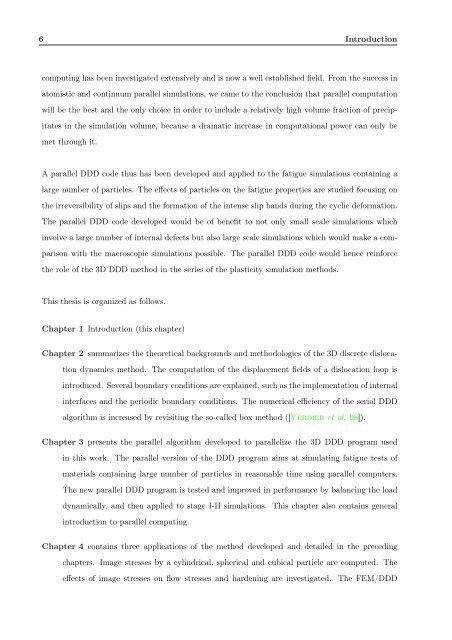3D DISCRETE DISLOCATION DYNAMICS APPLIED TO ... - NUMODIS
3D DISCRETE DISLOCATION DYNAMICS APPLIED TO ... - NUMODIS
3D DISCRETE DISLOCATION DYNAMICS APPLIED TO ... - NUMODIS
You also want an ePaper? Increase the reach of your titles
YUMPU automatically turns print PDFs into web optimized ePapers that Google loves.
6 Introduction<br />
computing has been investigated extensively and is now a well established field. From the success in<br />
atomistic and continuum parallel simulations, we came to the conclusion that parallel computation<br />
will be the best and the only choice in order to include a relatively high volume fraction of precip-<br />
itates in the simulation volume, because a dramatic increase in computational power can only be<br />
met through it.<br />
A parallel DDD code thus has been developed and applied to the fatigue simulations containing a<br />
large number of particles. The effects of particles on the fatigue properties are studied focusing on<br />
the irreversibility of slips and the formation of the intense slip bands during the cyclic deformation.<br />
The parallel DDD code developed would be of benefit to not only small scale simulations which<br />
involve a large number of internal defects but also large scale simulations which would make a com-<br />
parison with the macroscopic simulations possible. The parallel DDD code would hence reinforce<br />
the role of the <strong>3D</strong> DDD method in the series of the plasticity simulation methods.<br />
This thesis is organized as follows.<br />
Chapter 1 Introduction (this chapter)<br />
Chapter 2 summarizes the theoretical backgrounds and methodologies of the <strong>3D</strong> discrete disloca-<br />
tion dynamics method. The computation of the displacement fields of a dislocation loop is<br />
introduced. Several boundary conditions are explained, such as the implementation of internal<br />
interfaces and the periodic boundary conditions. The numerical efficiency of the serial DDD<br />
algorithm is increased by revisiting the so-called box method ([Verdier et al. 98]).<br />
Chapter 3 presents the parallel algorithm developed to parallelize the <strong>3D</strong> DDD program used<br />
in this work. The parallel version of the DDD program aims at simulating fatigue tests of<br />
materials containing large number of particles in reasonable time using parallel computers.<br />
The new parallel DDD program is tested and improved in performance by balancing the load<br />
dynamically, and then applied to stage I-II simulations. This chapter also contains general<br />
introduction to parallel computing.<br />
Chapter 4 contains three applications of the method developed and detailed in the preceding<br />
chapters. Image stresses by a cylindrical, spherical and cubical particle are computed. The<br />
effects of image stresses on flow stresses and hardening are investigated. The FEM/DDD


